College of Engineering & Management, Kolaghat

Approaved by AICTE New Delhi

Affiliated to MAKAUT West Bengal

NBA Accredited, CSE

Life Institution Membership of IEI
Alumni Registration Form




Highlights
| H.O.D | Dr. Samiran Pramanik |
|---|---|
| hodec@cemk.ac.in | |
| Mobile | +91 9800131891 |
| Phone | (03228)250971 Ext. 3221 |
| Type | Name | Duration | Intake |
|---|---|---|---|
| UG | B. Tech. in Electronics & Communication Engineering | 4 Years | 90 |
Departmental Links
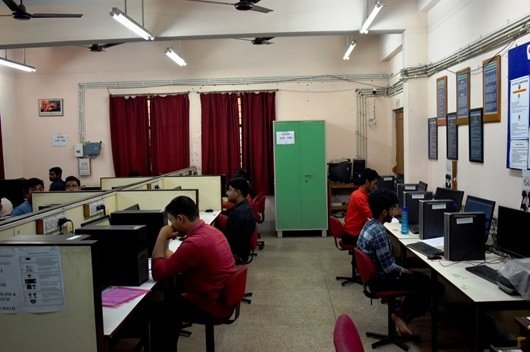
Laboratory Overview
Courses Conducted
Courses offered to: ECE, EE
Key Experiments & Learning Modules
A. Digital Signal Processing Lab (EC592)
Simulation Lab (MATLAB, Xilinx)
· Signal generation (sinusoidal, random sequences)
· Convolution & correlation of signals
· Z-transform & DFT/IDFT computations
· FIR/IIR filter design (Butterworth, Hamming, Blackman windows)
· Overlap-add & Overlap-save methods for long data sequences
Hardware Lab (TMS320C6713 DSP Kit & FPGA)
· Assembly programming for DSP operations
· VHDL coding for FPGA-based DSP implementations
· Real-time signal processing applications
B. Data Structures & Algorithms Lab (ES-CS391)
· Array, stack, queue implementations
· Linked list operations (insertion, deletion, reversal)
· Tree traversals (recursive & non-recursive)
· Sorting & searching algorithms (Quick Sort, Merge Sort, Binary Search)
· Hash table implementation & collision handling
C. Programming for Problem Solving Lab (ES-CS291)
· Basics of C programming (loops, functions, arrays)
· Matrix operations & string manipulations
· File handling & dynamic memory allocation
· Numerical methods (integration, differentiation, root finding)
Major Equipment & Software
Hardware:
Software:
Lab Supervision
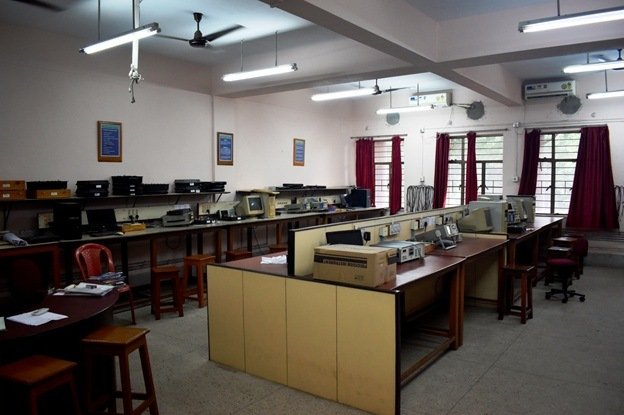
Laboratory Overview
Comm Lab-I: Room No. W-202
Courses Conducted
Courses offered to: ECE
Key Experiments
A. Digital Communication Lab (EC592)
B. Analog Communication Lab (EC491)
Major Equipment
· Analog & Digital Trainer Kits
· Communication Kits
· 100 MHz Digital Storage Oscilloscope (DSO)
· Spectrum Analyzer, Function Generators
· RF Amplifiers, CROs, LAN Switches
· PCs with simulation tools
Lab Supervision
· Lab In-Charge (Comm Lab-I): Dr. Seba Maity
· Technical In-Charge: Mr. Animesh Maiti
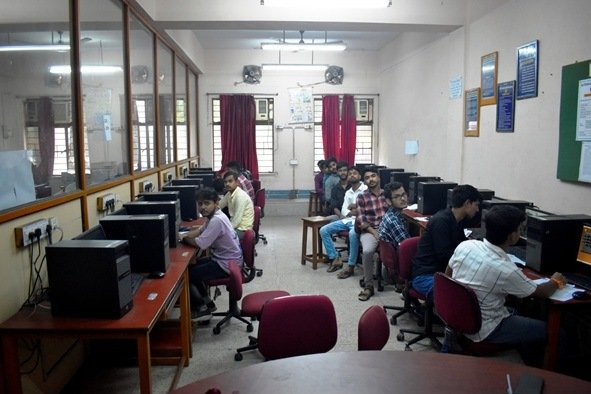
Laboratory Overview
Courses Conducted
Courses offered to: ECE, EE
Key Experiments
8085 Programming:
8051 Microcontroller:
Major Equipment
·
Lab Supervision
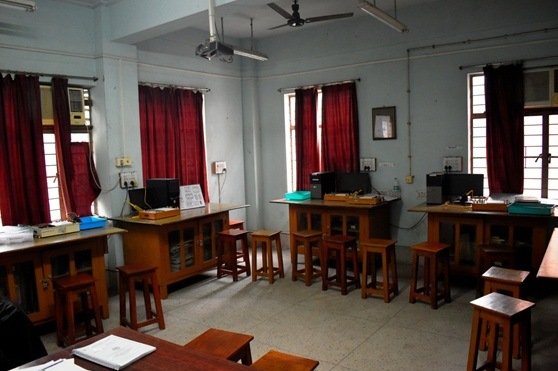
Laboratory Overview
o Lab-I: Room No. W-201
Courses Conducted
1. Analog & Digital Electronics (ESC-391)
2. Digital Electronics (PC-EE492)
Courses offered to: EE,CSE and IT
Key Experiments
Major Equipment
· Digital IC Tester, CRO, DSO, Function Generator, Analog-Digital Trainer Kits
Lab Supervision
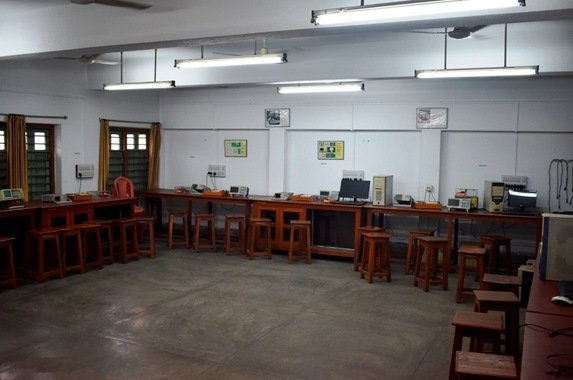
Laboratory Overview
Courses Conducted
Courses offered to: ECE, CSE and IT
Key Experiments and Projects
A. Digital System Design (EC392)
· Implementation of the Given Boolean Function using Logic Gates in Both SOP and POS Forms.
· Verification of State Tables of RS, J-K, T and D Flip-Flops using NAND & NOR Gates.
· Implementation and Verification of Decoder/De-Multiplexer and Encoder using Logic Gates.
· Implementation of 4x1 Multiplexer using Logic Gates.
· Implementation of 4-Bit Parallel Adder Using 7483 IC.
· Design, and Verify the 4- Bit Synchronous & Asynchronous Counter
· VHDL/Verilog coding for:
· PSPICE simulations:
B. Analog & Digital Electronics Lab (Code: ESC-391)
· Logic gate implementations (NAND, NOR universal gates)
· Adder/Subtractor , Flip-flops, Counters, Shift Registers
· 555 timer, Multivibrators, Design of Schmitt Trigger, Amplifiers, Oscillators
C. Mini-Project & Design (EC681)
A. Mini-Project & Design (EC681)
· Rectifier Design with performance analysis
· DC Power Supply with regulation & protection
· BJT & JFET Amplifiers for audio applications
· Power Amplifier with crossover distortion study
· Oscillator Circuits – RC, Wien Bridge, Hartley, Colpitts
· Inverting & non-inverting amplifiers
· Adder/Subtractor for AC & DC signals
· Comparator with adjustable hysteresis
· Active Filters (LP, BP, HP)
· 555 Timer (Monostable/Astable) circuits
· BCD to 7-Segment Decoder
· 4-Digit Frequency Counter
· Logic functions using MUX/DEMUX
· Sequence Detector using FSM
· Logic + RAM for data generation & retrieval
· Single-phase controlled converter
· Microprocessor-based triggering circuit
Major Equipment
· Analog - Digital Trainer Kits
· 100 MHz DSO, Function Generators
· PCs with EDA Tools
· Laser Printer
Lab Supervision
· Lab In-Charge: Dr. Hirak Kumar Maity
· Technical In-Charge: Ms. Jhuma Datta
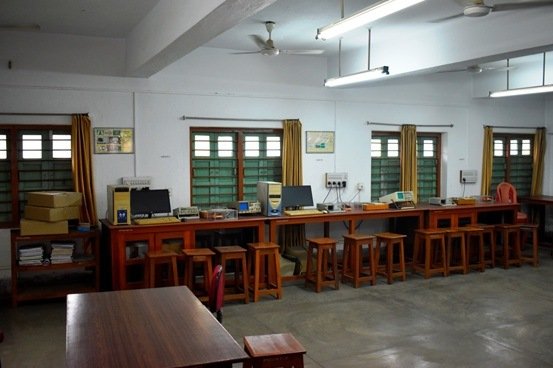
Laboratory Overview
Courses Conducted
Courses offered to: ECE
Key Experiments
A. Basic Electronics Engineering
· PN junction diode characteristics
· Zener diode voltage regulation
· BJT/FET parameter extraction
· CE amplifier frequency response
B. Electronics Devices Lab (EC391)
· Study of basic components: resistors, capacitors, diodes, LEDs, BJTs, JFETs, MOSFETs.
· Familiarization with lab instruments: power supply, oscilloscope, multimeter.
· PN Junction Diode: V-I characteristics, cut-in voltage, resistances.
· Zener Diode: V-I and load regulation, breakdown voltage.
· BJT (CB & CE): Input/output characteristics, h-parameters.
· Self-bias BJT circuit design.
· JFET (CS): Drain/transfer characteristics
· Optoelectronic devices:
Major Equipment
·
· CROs (30MHz+)
· DSOs
· Analog-Digital Trainer Kit
· Digital Multimeter
· Function Generators
· Personal Computer
Lab Supervision
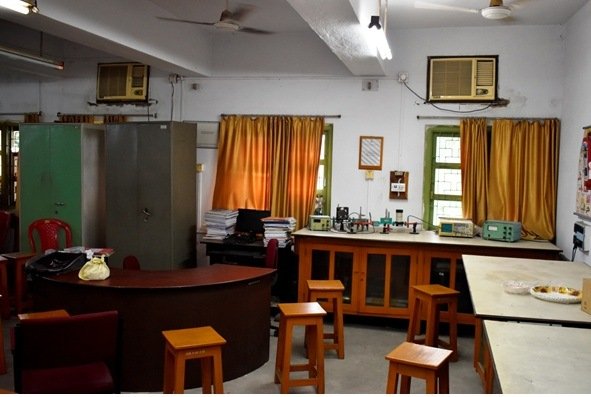
Laboratory Overview
· Location: Room No. AN-208
· Room Type: Air-conditioned
· Area: 125.66 sq. m.
· Network Facility: LAN Enabled
· Student Capacity: 34 students
· Batch Size: 24-30 students
Course Conducted
EM Theory & Transmission Line (EC491)
Courses offered to: ECE
Key Experiments
· Antenna characterization:
o Radiation pattern measurement
o Gain/directivity calculations
· Waveguide analysis:
o Impedance measurements
o VSWR/reflection coefficient studies
· Smith chart applications
· Printed antenna testing
Major Equipment
· Klystron/Gunn Diode Test Benches
· Vector Network Analyzer
· Pyramidal/Horn Antennas
· Advanced Spectrum Analyzers
· ANSYS HF Simulation Suite
· CROs (30MHz+)
· Digital Multimeter
· Function Generators
· Personal Computer
· Multimedia Projector
Lab Supervision
· Lab In-Charge: Prof. Samiran Pramanik
· Technical In-Charge: Ms. Jhuma Datta
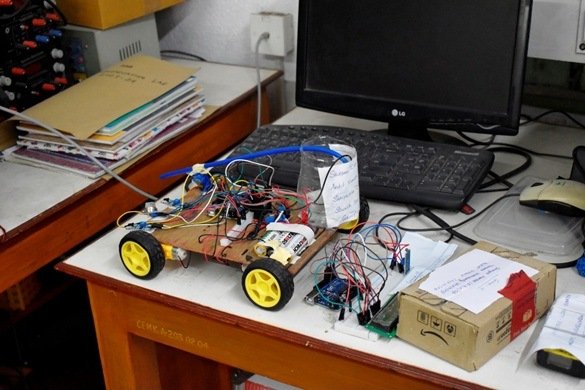
Laboratory Overview
· Location: Room No. AN-204
· Room Type: Air-conditioned
· Area: 30.6 sq. m.
· Network Facility: LAN Enabled
· Student Capacity: 32 students
Key Objectives & Activities
A. Project Stage I (EC781)
Objective:
To initiate students into research and development in the field of Electronics & Communication Engineering through theoretical, practical, or combined investigative study, either individually or in small groups, under faculty supervision.
Key Activities:
· Literature review and survey
· Problem identification and preliminary approach formulation
· Initial analysis, modeling, simulation, or feasibility study
· Interim report preparation
· Final seminar and presentation to departmental committee
B. Project Stage II (EC782)
Key Activities:
· Detailed design and prototyping
· System development and integration
· Performance analysis and testing
· Thesis documentation and submission
· Preparation of research paper for conference/journal submission
Major Equipment
· Soldering Stations
· Bread Board, Veroboard
· Oscilloscopes (CRO, DSO)
· Function Generator
· Analog-Digital Trainer Kit
· Digital Multimeters
· Personal Computer
Lab Supervision
· Lab In-Charge: Prof. Paramita Mukherjee
· Technical In-Charge: Mr. Bikash Chandra Bag
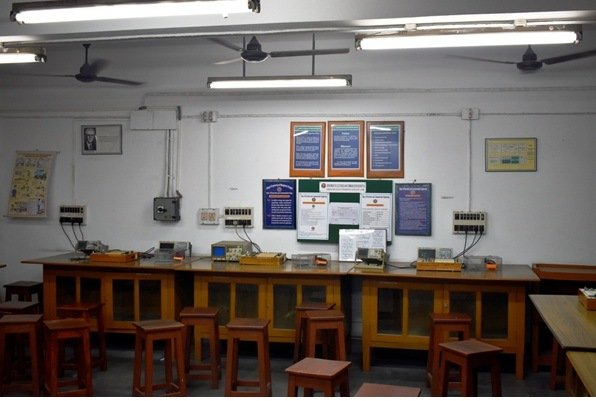
Laboratory Overview
· Location: Room No. N 213
· Room Type: Air-conditioned
· Area: 60.3 Sq. m.
· Network Facility: LAN Enabled
· Student Capacity: 35 students
· Batch Size: 25-30 students
Course Conducted
Analog Electronic Circuits Lab (Code: EC 492)
Courses offered to: ECE
Key Experiments
· Diodes and Regulation: Clipping, clamping, rectifier circuits (with/without filters), and Zener-based voltage regulation.
· Transistor Characteristics: Study of BJT, JFET, and MOSFET characteristics and key parameters.
· Amplifier Circuits: Design and analysis of BJT, Darlington, and FET amplifiers for gain and frequency response.
· Power and Oscillator Circuits: Class-B push-pull power amplifier and BJT-based RC/Wien bridge oscillators.
Major Equipment
· CROs (30MHz+)
· DSOs
· Analog-Digital Trainer Kit
· Digital Multimeter
· Function Generators
· Personal Computer
Lab Supervision
· Lab In-Charge: Prof. Dipankar Saha
· Technical In-Charge: Ms. Shipra Bhattacharya
P.O. KTPP Township, Purba Medinipur,
Pin: 721171, West Bengal
+91 8617653058
Admission Helpline: 9609064108; 033 6902 9851
director@cemk.ac.in
Copyright © CEM, Kolaghat. All Rights Reserved.